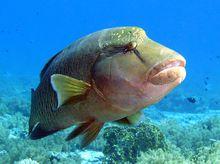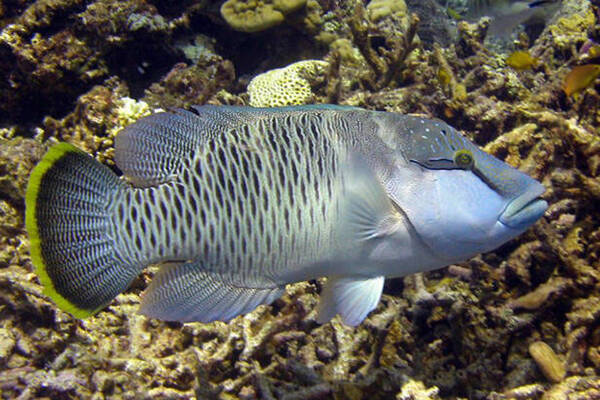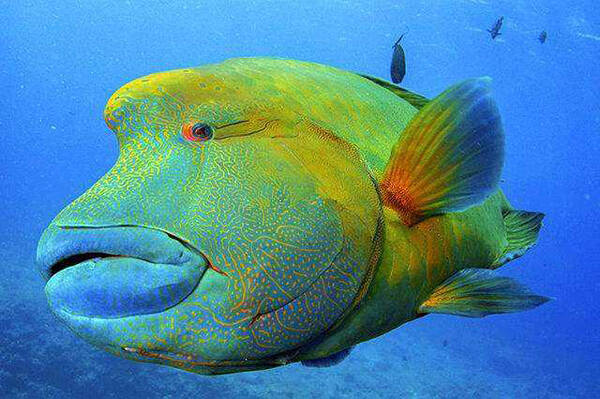
Alias Cheilinus undulatus,Giant Wrasse,Napoleon wrasse, wavy parrotfish, curved lip fish, Napoleon bream, dragon king bream, sea bream, big piece
Family Perciformes Wrasseidae Lipichthys
Cheilinus undulatus (scientific name: Giant Wrasse) is a large wrasse with no subspecies.

Cheilinus undulatus is usually solitary, but may sometimes appear in pairs. Adult fish cruise between reefs during the day and live in reef caves and under coral shelves at night. Although the rippled lip fish is the largest coral fish, it is easily frightened and will burrow into the coral reef for safety when frightened. The rippled lip fish is gentle and easy to get close to people. It is loved by divers because it even allows divers to touch it.
The rippled lip fish has a set of skills to deal with prey. If the prey hides in the cracks of the coral reef, it will extend its jaws to clamp the prey tightly and drag it out. For cryptic prey, it will bite off the coral branches where the prey hides, or catch the prey by blowing away the covering such as mud and sand with a strong jet of water. If the prey burrows under the stone, the rippled lip fish will turn the stone over with its powerful jaws, and it will also use its hard pharyngeal teeth to crush the hard shells of crustaceans.
The wavy lip fish is a carnivorous fish. The wavy lip fish has a wide diet, mainly fish and benthic animals, and also feeds on many kinds of invertebrates. Food includes mollusks, fish, sea urchins, crustaceans and other invertebrates. In addition to fish, there are also many poisonous and thorny animals, such as sea urchins, crown-of-thorns starfish, hard-scaled fish, and sea hares. The wavy lip fish will not be poisoned after eating these poisonous animals, but the toxins will accumulate in the wavy lip fish. Consumers will be poisoned if they eat the wavy lip fish that has not been cleaned of toxins.
The growth period of the wavy lip fish is relatively long, generally 7-8 years, the reproductive period is from April to July, and the spawning fish can reach 80,000 to 120,000. This species can live for at least 30 years (25 years for males and 32 years for females), and reaches sexual maturity after 6 years. It is a hermaphroditic fish, and an important feature of this type of fish is that it can change sex in a certain period of time. Most wavy lips remain the same sex after birth, and only a small number of adult female wavy lips have the opportunity to become males. Among this small number, the larger female wavy lips have the opportunity to become super males, which often happens when another super male wavy lips leader dies. The super male wavy lips is the leader of a group of wavy lips. It is larger than all other male wavy lips and has unique colors and patterns.

The wavy lip fish will choose to gather in groups to mate and lay eggs when the new moon rises during the breeding season. At that time, the super male wavy lip fish will mate with most of the female wavy lip fish. The super male wavy lip fish is also responsible for patrolling its territory. Once another group of wavy lip fish invades, it will violently drive away the invading male wavy lip fish and mate with the female wavy lip fish in the invading group.
Unlike many migratory fish, wavy lip fish do not spawn in their birthplace. Their entire mating and spawning process is also very short, not exceeding one day. After the wavy lip fish mates and lays eggs, the fertilized eggs will float to the photosynthesis zone of the ocean and hatch into juvenile fish there. Juvenile fish generally live in lagoons rich in inner coral polyps and swim to the outer coast when they grow up.
Wavy lip fish is a high-end edible fish. Because of its shortage of resources and high price, it is suitable for high-end banquets. It has delicate meat and delicious taste. The wavy lip fish has a high meat yield and contains a variety of essential amino acids, fatty acids and minerals for the human body. It is a high-quality animal protein with high nutritional value and delicious meat. The wavy lip fish is the largest existing coral fish with a unique appearance. Therefore, it is also a high-level ornamental fish. It appears in aquariums and large ornamental fish tanks for human appreciation.
The wavy lip fish has few natural enemies and a low natural mortality rate. It was once widely distributed in the Indian Ocean and the Pacific Ocean. Studies in most regions have shown that the population of the wavy lip fish has decreased by at least 50% (2003) in the past 30 years due to the gradual decline in commercial trade. The sharp decline rate was as high as 90% at one time. And there is a trend of accelerated decline. Many young fish are caught before they reach reproductive age, resulting in fewer and fewer adult fish that can reproduce. Improper behavior during fishing threatens not only the survival of the species, but also the fragile coral reef ecosystem.
The wavy lip fish has long been traded as an economic fish. The meat of the wavy lip fish is tender and is a famous delicacy. However, due to its small number and high price, a kilogram of wavy lip fish can be sold for $200, and a plate of fish lips can be sold for $300. It is the high price that stimulates some people to continue to take risks to catch wavy lip fish. The population density of wavy lip fish is not high. In areas that have not been fished or lightly fished, there are an average of 2 to 20 adult wavy lip fish (rarely more than 10) per hectare of coral reef, which is far from the minimum density required for economic fish. In heavily fished areas, the population density will drop to one-tenth of the original, and some areas have even become extinct. The World Wildlife Fund has listed the wavy lip fish as one of the 10 endangered species. The wavy lip fish, which had never been on the list before, has suddenly ranked second among endangered species. There are less than 100,000 wavy lip fish in the world (2016).
Listed in the 2004 Red List of Endangered Species of the World Conservation Union (IUCN) ver 3.1 - Endangered (EN).
Listed in the second level of the List of Wildlife under State Protection in China. (Wild populations only)
Protect wildlife and eliminate game.
Maintaining ecological balance is everyone's responsibility!